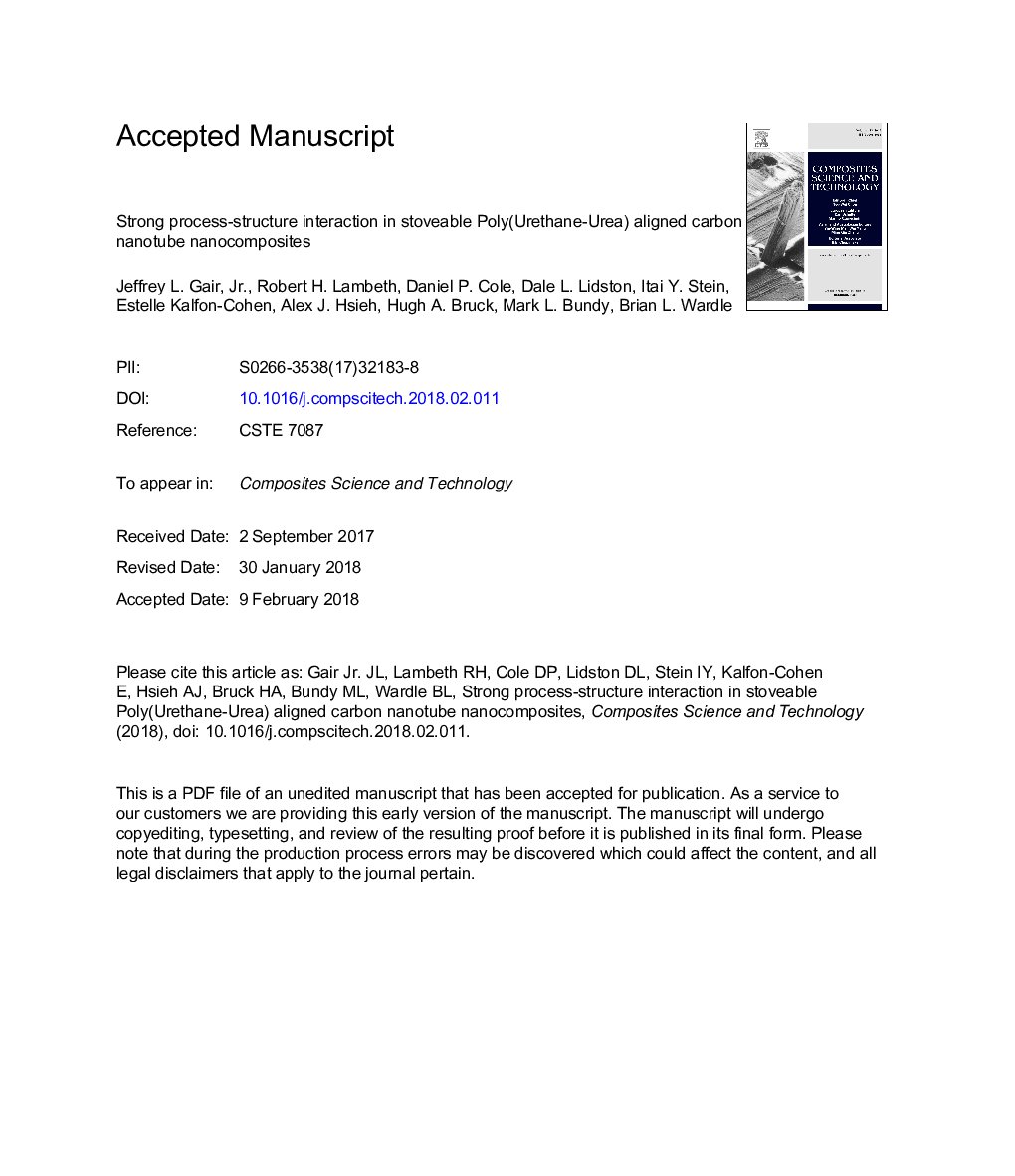| کد مقاله | کد نشریه | سال انتشار | مقاله انگلیسی | نسخه تمام متن |
|---|---|---|---|---|
| 10226558 | 1701277 | 2018 | 40 صفحه PDF | دانلود رایگان |
عنوان انگلیسی مقاله ISI
Strong process-structure interaction in stoveable poly(urethane-urea) aligned carbon nanotube nanocomposites
ترجمه فارسی عنوان
تعامل سازنده فرآیند ساختار در نانوکامپوزیت های نانولوله کربنی پلی کربنات پت (اورهن-اوره)
دانلود مقاله + سفارش ترجمه
دانلود مقاله ISI انگلیسی
رایگان برای ایرانیان
موضوعات مرتبط
مهندسی و علوم پایه
سایر رشته های مهندسی
مهندسی (عمومی)
چکیده انگلیسی
The exceptional static and dynamic physical properties of poly(urethane-urea) (PUU) elastomers make them prime candidates for impulsive loading structural applications, such as blast protection coatings. Since the theoretical physical properties of carbon nanotubes (CNTs) are among the best for any currently known material, a number of previous studies explored the use of CNTs as nanoscale fillers to enhance the properties of PUU nanocomposites. However, due to the challenges inherent in dispersing CNTs in a PUU matrix and the resulting random orientation of the CNTs, these previous works observed marginal improvements in physical properties, and were unable to establish clear structure-property relations. Here, we report the synthesis of aligned-CNT (A-CNT) reinforced PUU polymer nanocomposites (A-PNCs) by infusing A-CNT forests with a stoveable PUU, and establish process-structure-property relations that quantify the contribution of CNT confinement on the PUU mechanical response. This stoveable process was achieved using blocked isocyanate which prevented polymerization until the blocks were removed with heat. PUUs of two distinct compositions were explored: one with 40â¯wt% hard-segment content (PUU211) and the other with 66â¯wt% hard-segment content (PUU541). Thermogravimetric analysis indicates that A-CNTs enhance the thermal stability of the hard-segment phase in PUU A-PNCs at 340â¯Â°C by up to 45% over the baseline PUUs. Atomic force microscopy reveals that the elongated nanophase hard-segment formations along the CNT axis observed only in the nanocomposites were of similar characteristic size to the average inter-A-CNT spacing (â¼70â¯nm), indicating a strong influence of A-CNTs on the size and orientation of hard-segment nanophases, as corroborated via small angle X-ray scattering. Nanoindentation testing reveals that PUU A-PNCs possess significant elastic anisotropy, and exhibit enhanced longitudinal effective indentation moduli of â¼460â¯MPa (>3â¯Ãâ¯that of the PUU211 baseline) and â¼1350â¯MPa (â¼1.5â¯Ãâ¯that of the PUU541 baseline) for PUU211 and PUU541 nanocomposites, respectively. This difference in magnitude of CNT reinforcement efficacy indicates that CNT confinement leads to significant hard-segment re-organization in the PUU211 A-PNCs, whereas the interconnected network of hard-segments in the PUU541 is affected by CNT templating to a lesser extent. Dynamic nanoindentation testing results are consistent with these interpretations, where longitudinally-loaded PUU211 A-PNCs are found to exhibit a >3â¯Ãâ¯enhancement in storage modulus at 1â¯Hz of â¼730â¯MPa, whereas the longitudinally-loaded PUU541 A-PNCs exhibit a slightly enhanced storage modulus enhancement at 1â¯Hz of 2190â¯MPa (â¼1.5â¯Ãâ¯that of the PUU541 baseline). Reinforcement of PUUs with A-CNTs is a promising way to tune the physical properties of the PNCs; higher A-CNT packing densities, where the inter-CNT spacing could approach the nanophase characteristic diameter, could further enhance the PUU performance in ballistic protection applications.
ناشر
Database: Elsevier - ScienceDirect (ساینس دایرکت)
Journal: Composites Science and Technology - Volume 166, 29 September 2018, Pages 115-124
Journal: Composites Science and Technology - Volume 166, 29 September 2018, Pages 115-124
نویسندگان
Jeffrey L. Jr., Robert H. Lambeth, Daniel P. Cole, Dale L. Lidston, Itai Y. Stein, Estelle Kalfon-Cohen, Alex J. Hsieh, Hugh A. Bruck, Mark L. Bundy, Brian L. Wardle,
